The survival function #
Review of probability random variables #
Now is the last time to brush up on probability concepts:
review probability concepts and associated video on the website
- A random variable, denoted by capital letters such as
- A random variable takes values from a set of possible different numbers.
Examples:
- The number
- Tomorrow’s temperature at 12:00pm.
- Tomorrow’s exchange rate from Australian dollar to US dollar.
- The future life time of a life aged 30.
Definitions #
Mortality:
- There are many different ways of modelling mortality.
- analytical models – such as the survival function – which are designed to ‘fit’ to statistical data which have been collected about a population.
- life tables (see next section)
- Notation:
There are different definition of age:
- exact age: 30.5, 19, or one month to 20.
- age last birth day:
- if exact age is in
- if exact age is in
- age next birthday:
- if exact age is in
- if exact age is in
- age nearest birthday
- if exact age is in
- if exact age is in
Survival function #
- We call
- This function can be of any analytical form provided it is consistent with the individuals whose mortality experience it represents.
- However, it must satisfy the following conditions:
- Any function fulfilling these three conditions can be used as a survival function, but may not be suitable for a human population.
Example 1 #
Let
Is this function suitable for use as a survival function?
We have:
Therefore, it is suitable over [0, 20].
Is the function
Lifetime distribution #
We define
- This is what is called a distribution function, and it must fulfill conditions analogously to the survival function
- To think of it another way,
Either you are alive or you are dead by age
Future lifetime #
Notation:
Important:
What about
An important result:
This stems from Bayes’ rule: for two events
Proof of
- Let
- Let
- Then
- Then
- As the events
Probability of dying over the next
The probability
This can be proven using the fact that
Assumption of independence #
Warning:
- In actuarial problems it is usual to assume that lives are independent with respect to mortality.
- In practice, this assumption may not be true. For example, events such as car crashes often result in the death of more than one member of a family. We might expect members of a family to be dependent mortality risks.
- Recall from probability theory that for two independent events
Examples #
Example 2 #
There are three siblings, aged 10, 12 and 15, all born on the same (calendar) day. Today is their birthday. Assume their lives are independent.
- What is the probability that they will all survive to attend each others’ 21st birthday parties?
- What is the probability that the youngest survives the next 5 years, and the eldest does not?
We have:
- The must all survive to the youngest 21st:
Example 3 #
Let
- What is the probability that (30) lives to age 60?
- What is the probability that (30) will survive to age 60, but not to age 70?
We have:
- This is the probability that (30) will die between 60 and 70, i.e. that
The force of mortality
Definition #
Recall
- this is ($\approx$) equal to the pdf of
We have
We have
We now show that
Example 4 #
Suppose that
One more step to obtain the pdf of
What if
- we have to account for the probability of surviving
We have then
We can now calculate the expected future lifetime of
Example 5 #
The lifetime of a light bulb is sometimes modeled using an exponential distribution:
- the probability that the bulb will fail before
- the probability that it will function more than
- its failure rate (that is, its “mortality” rate);
- its expected lifetime;
- the probability that it will function for another
Answers:
Example 6 #
For a certain population,
- What is the force of mortality,
- Calculate
- What is the (exact) probability that
- Using
Answers:
- We have
- Set
- This is
- Approximately,
The life table #
Introduction #
- A life table
- represents the experience of a particular group,
- is usually named after that group, and
- is constructed based on data collected from the experience of that group.
- It is an historical alternative to using an analytical survival function, but it retains some advantages.
- The process of constructing life tables is called “graduation.”
For example, Australian Life Tables 2000-02 show national population experience around 2001, based on the national census.
There are life tables for a special groups of lives, e.g.,
- annuitants, (often lower mortality)
- pensioners,
- insured lives,
- particular groups of insured (e.g. members of a large industry super fund)
- men or women, etc, based on data gathered from appropriate groups.
Insurance companies have gathered much information from their policyholders over long periods of time, and the life tables they construct are widely used to calculate premium rates, probabilities of death and survival, etc.
Australian Life Tables 2000-02 #
Here is an extract from Australian Life Tables 2000–02 for Females, published by the Australian Government Actuary.
| 0 | 100,000 | 466 | 0.00466 | 0.99534 |
| 1 | 99,534 | 42 | 0.00042 | 0.99958 |
| 2 | 99,492 | 19 | 0.00019 | 0.99981 |
| 3 | 99,473 | 16 | 0.00016 | 0.99984 |
What do these columns represent?
Life table functions #
- We have
Mechanics of the table #
Given a survival function,
Suppose we known mortality rates
- First, set the value of
- Next, calculate
- Repeat these steps at age 1: calculate
- Continue in this manner.
However, while this helps understanding what the table menas, this is often besides the point!
- the point of having a table is to fit mortality rates to a given data set;
- the “shape” and “turns” of the function may not follow a simple parametric function.
Two identities #
Basic calculations #
Note that
Example 7 #
Based on the extract from Australian Life Tables 2000–02 for Males,
- What is the probability of (60) surviving for at least 5 years?
- What is the probability of (60) dying before age 65?
- What is the probability of (60) dying aged 62?
Answers:
Aggregate life table functions #
Let
Properties:
- Because there are no entries (and only deaths):
- Because deaths are roughly uniformly distributed in time (but not perfectly since there are less people there to die at the end than at the beginning, and they are generally more likely to die):
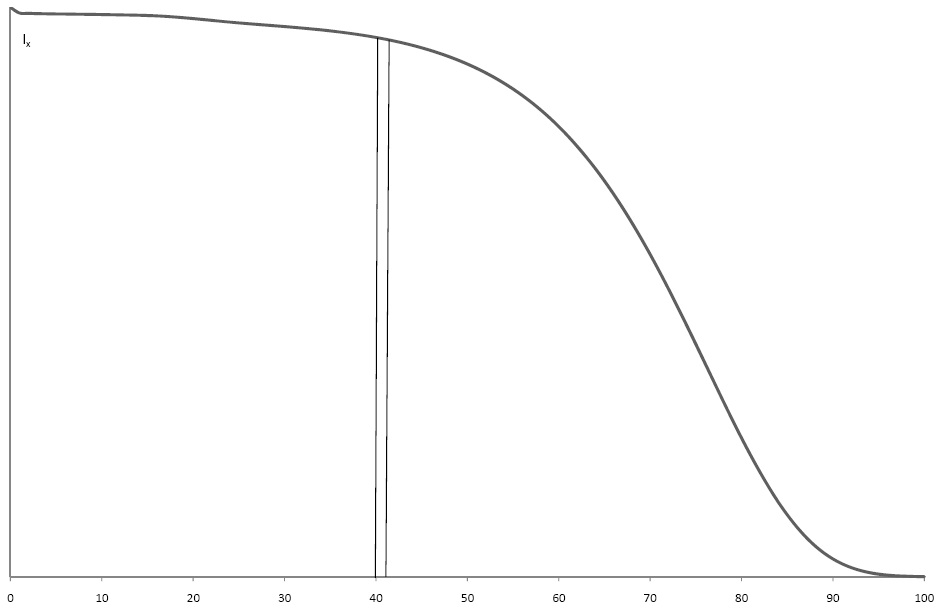
- the curve is
- the area under the curve between 40 and 41 is
Define
Properties:
It can be shown that
Additionally,
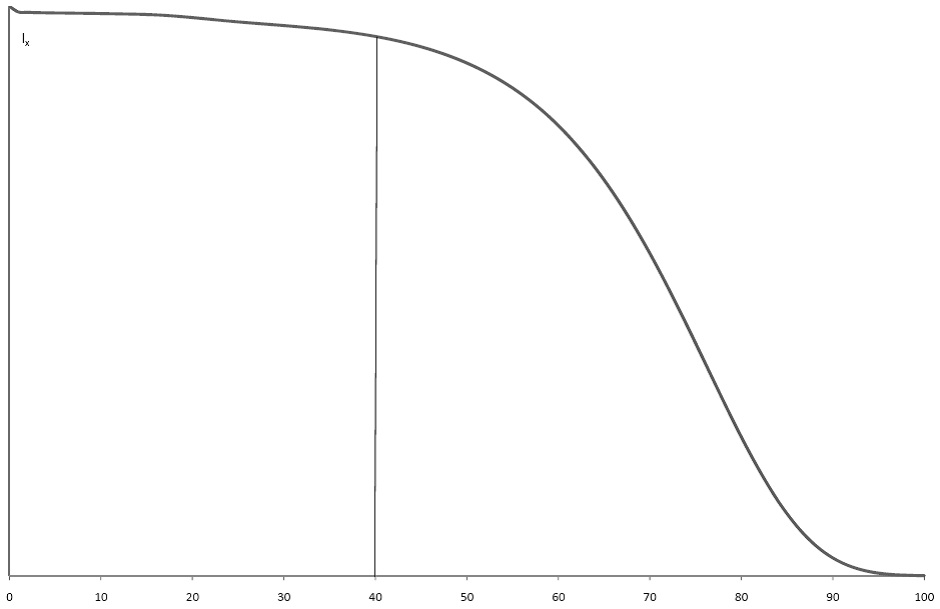
- the curve is
- the area on the RHS of the vertical line at 40 is
Stationary populations #
Let us conduct the following thought experiment: Let us assume the table represents a stationary population. This means that the number entering the population each year is the same as the number leaving it:
- the number of births is equal to the number of deaths if immigrations and emigrations are not considered.
- the population size is unchanged with time (zero growth rate);
- the size of a certain age group is unchanged with time;
- the mortality rate
- we assume births are uniformly distributed throughout the year.
We can further interpret:
Why does
- Recall that
- We assumed that births are uniformly distributed over the year, then

- the numbers of births today (aged 0 exactly today) is
- the number of lives born yesterday surviving to today, aged 1 day or
- Similarly,
- Finally,
Wrapping up,
Now generalising, why does
- We assumed that birthdays are uniformly distributed over the year, then

Example 8 #
The following is an extract from a published life table.
| 0 | 100,000 | 986 | 0.99014 | 0.01520 | 99,424 | 6,909,573 |
| 1 | 99,014 | 66 | 0.99933 | 0.00529 | 98,942 | 6,810,149 |
| 2 | 98,948 | 40 | 0.99960 | 0.00054 | 98,927 | 6,711,208 |
| 3 | 98,908 | 30 | 0.99970 | 0.00035 | 98,892 | 6,612,281 |
| 4 | 98,878 | 26 | 0.99974 | 0.00028 | 98,865 | 6,513,389 |
| 5 | 98,852 | 24 | 0.99976 | 0.00025 | 98,840 | 6,414,524 |
- Calculate the probability that a newborn life survives to age 5. Give your answer to 5 decimal places.
- Calculate the probability that of two lives aged 2, exactly one of them survives to age 5. Give your answer to 5 decimal places. You may assume that these two lives are independent with respect to mortality.
- Calculate
- Estimate the probability that a baby aged exactly 1 will die in two days. Give your answer to 5 decimal places
Answers:
- The estimated probability is
Example 9 #
The population of a country experience the mortality of the life table in Example 8. The population of this country has reached a stationary condition with
- the crude birth rate (CBR) for this country,
- the crude death rate (CDR) for this country,
- the population size aged under 5.
Answers:
- CBR=CDR, as the number of births is equal to the number of deaths in a stationary population.
Curtate future lifetime #
Expected Value of a Discrete Random Variable #
Suppose a random variable,
The expected value of the random variable
Curtate future lifetime #
Recall:
We define a random variable
We call
For example:
- if (40) dies at age 75.6,
- if (30) dies at age 82.3,
Pmf of
How do we find
Answer:
Thus,
Generalising:
Curtate expectation of life #
The expected value of
Using the pmf obtained earlier we have:
Developing yields
Thus, we get the important formula,
Example 10 #
Consider the survival function
Show that
Solutions:
We have
Thus
Expectation of life in Australia #
The plot shows expectation of life at birth in Australia. Source: ABS
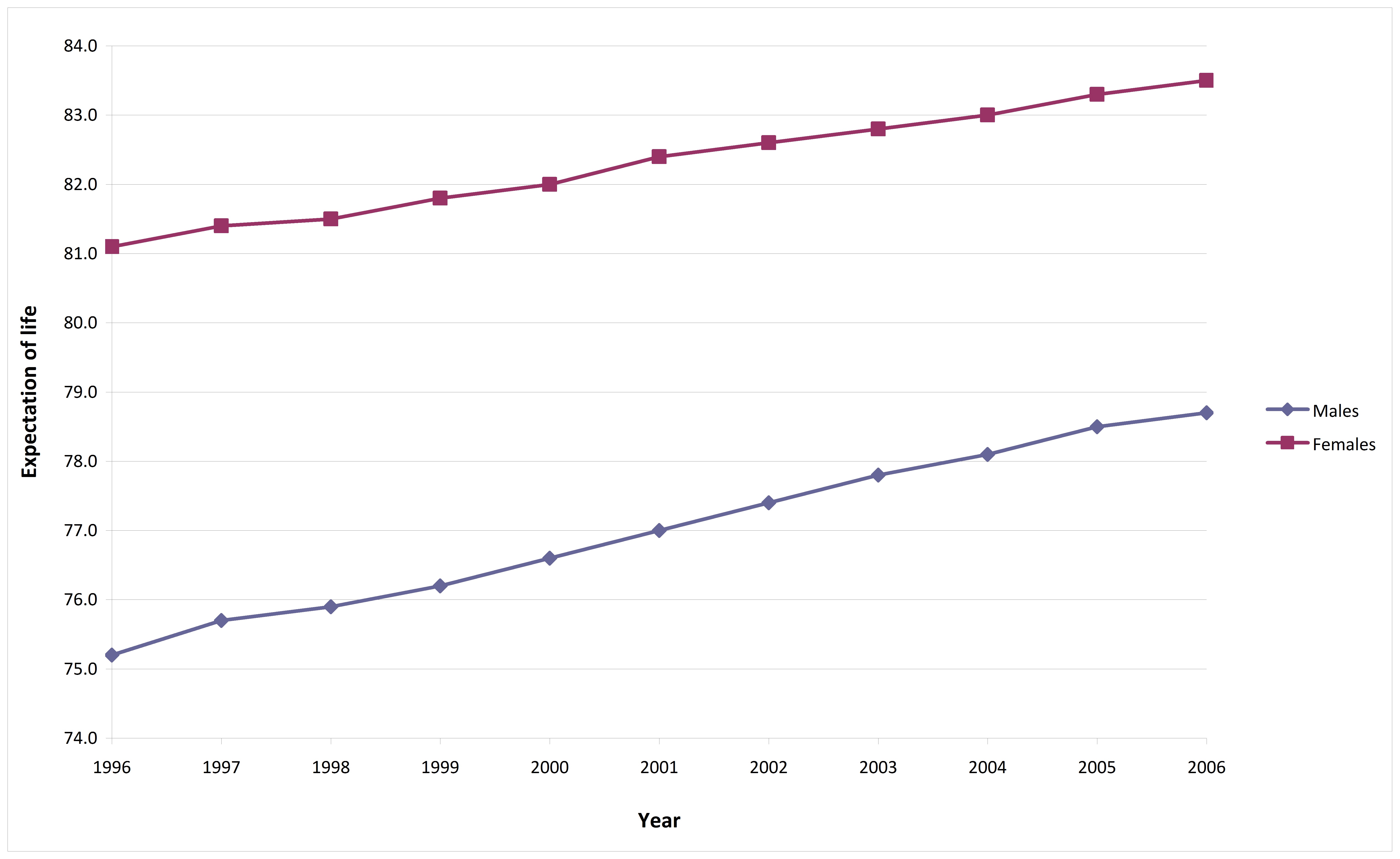
Expectation of life around the World #
The table shows expectation of life from birth in 2005 for some countries.
| Country | Expectation of Male Life | Expectation of Female Life |
|---|---|---|
| Belgium | 75.44 | 81.94 |
| Canada | 78.55 | 83.54 |
| Kenya | 53.35 | 53.10 |
| Nicaragua | 68.27 | 72.49 |
| Pakistan | 62.04 | 64.01 |
| Singapore | 79.05 | 84.39 |
Source: US Census Bureau
These are life expectations calculated using a period table. They are often misinterpreted.
Period vs Cohort tables #
- Period tables describe mortality of a population in a given year (so different individuals of different age, all in the same calendar year). So there are potentially different period tables for different calendar years of death.
- Cohort tables look at the mortality of people born in the same calendar year – they track mortality of a given cohort. So there are potentially different cohort tables for different calendar years of birth.
Characteristics, causes and trends of mortality experience #
- Life tables are very important in traditional actuarial work.
- They are constructed from past experience, but may also include an allowance for ‘improving mortality’ – changes in mortality rates since the data were collected.
- Different tables are constructed based on different ‘exposed to risk.’ Calculations of quantities such as premiums are based on the assumption of a particular mortality experience, perhaps adjusted in some way – using the rate for a higher or lower age, or making a percentage loading on the tabulated rate.
- For example, there are tables based on annuitants’ data, which reflect the mortality experience of people who have purchased annuities. These people expect to have low mortality, otherwise they would not buy an annuity – they are ‘self selecting’ on this basis.
- Australian Life Tables are based on the whole Australian population, without any special features to affect their experience. We would expect the mortality rates to be higher than for annuitants.
- On the other hand, those who buy life insurance are insuring their lives and so are self-selecting on that basis – so we would expect, and we find, that their mortality rates are higher than for annuitants.
- So, choosing the appropriate table, and whether and how to adjust the rates is of primary importance in actuarial calculations.
In what follows, we illustrate some of the main features of human mortality in Australia.
Australian Life Tables 2000-02 #
This graph shows
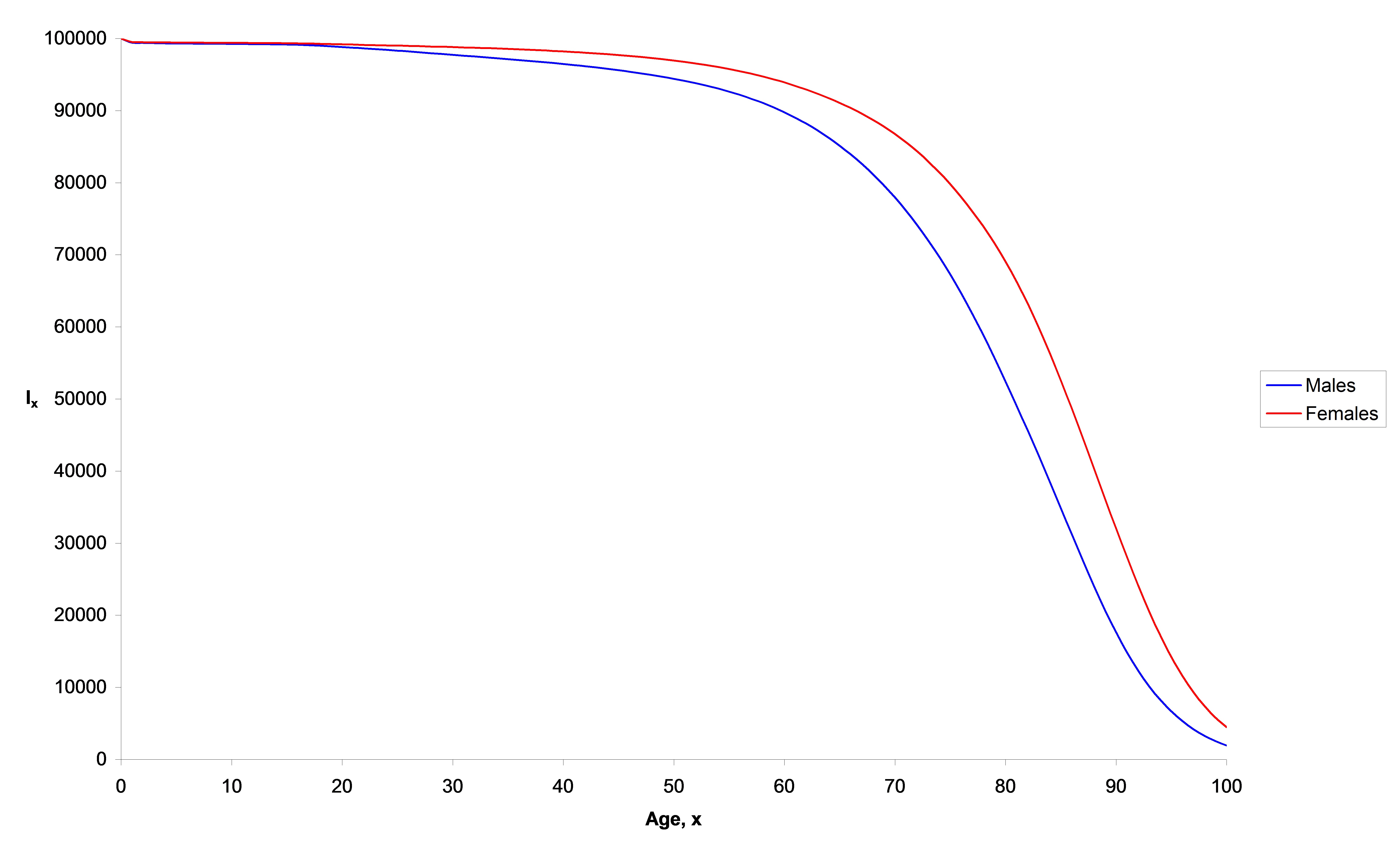
Australian Life Tables 2000–02 – Mortality Rates #
This graph shows
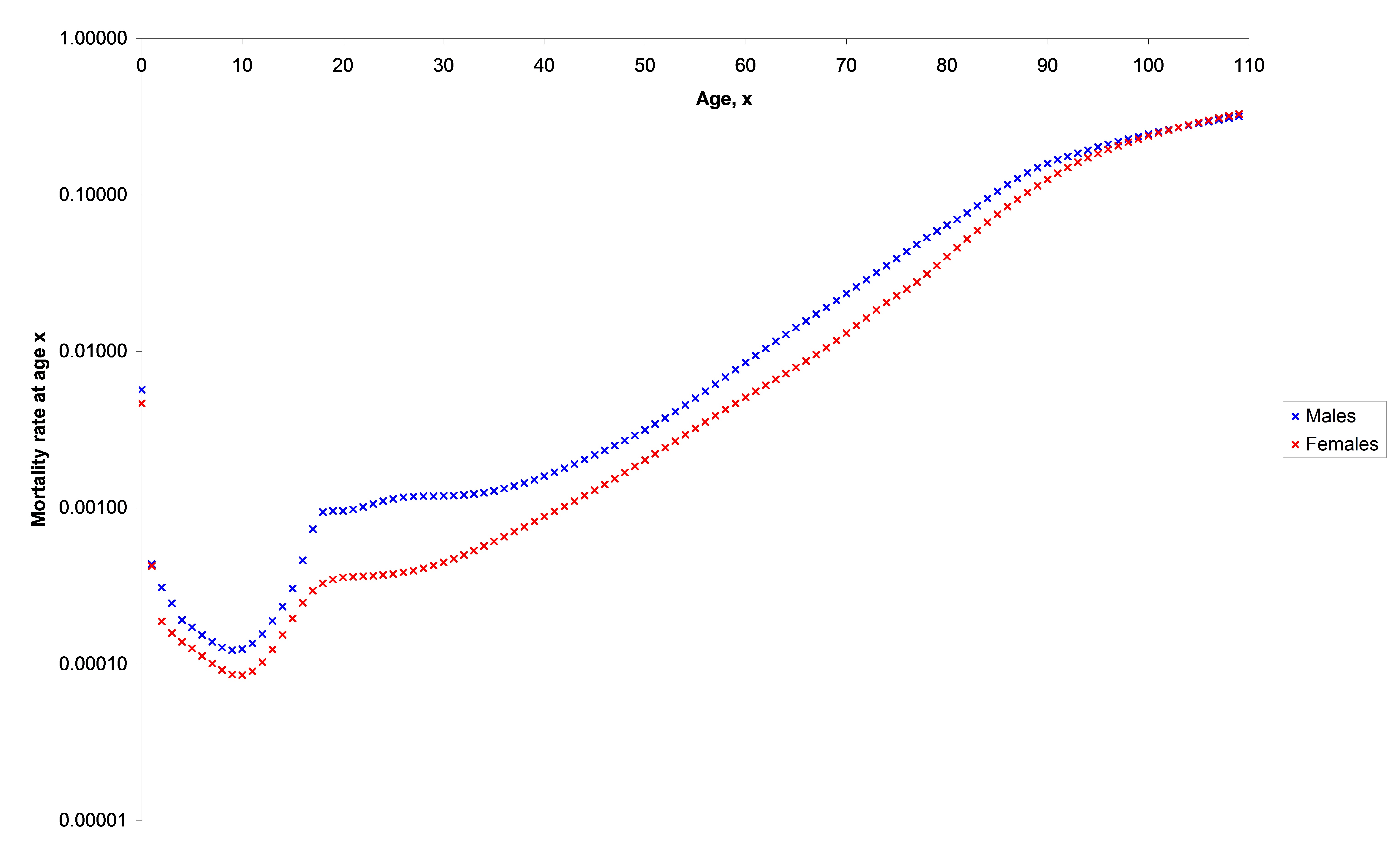
Australian Life Tables 2000–02 – Mortality Rates #
Some of the key features include:
- Life in the first years is risky.
- There is a ‘bump’ around the late twenties, where accidental death from risky behaviour becomes noticeable for males. This has tended to reduce for males, and increase for females.
- Mortality rates start to increase more steeply around ages 40-45.
Mathematical models of mortality #
Two theoretical models #
- Various ‘laws of mortality’ have been proposed over the years.
- Two old and famous ones are:
- Gompertz Law (1825):
- Makeham’s Law (1860):
- Gompertz Law (1825):
- How do these compare to mortality nowadays?
The force of mortality in Australia #
The plot shows
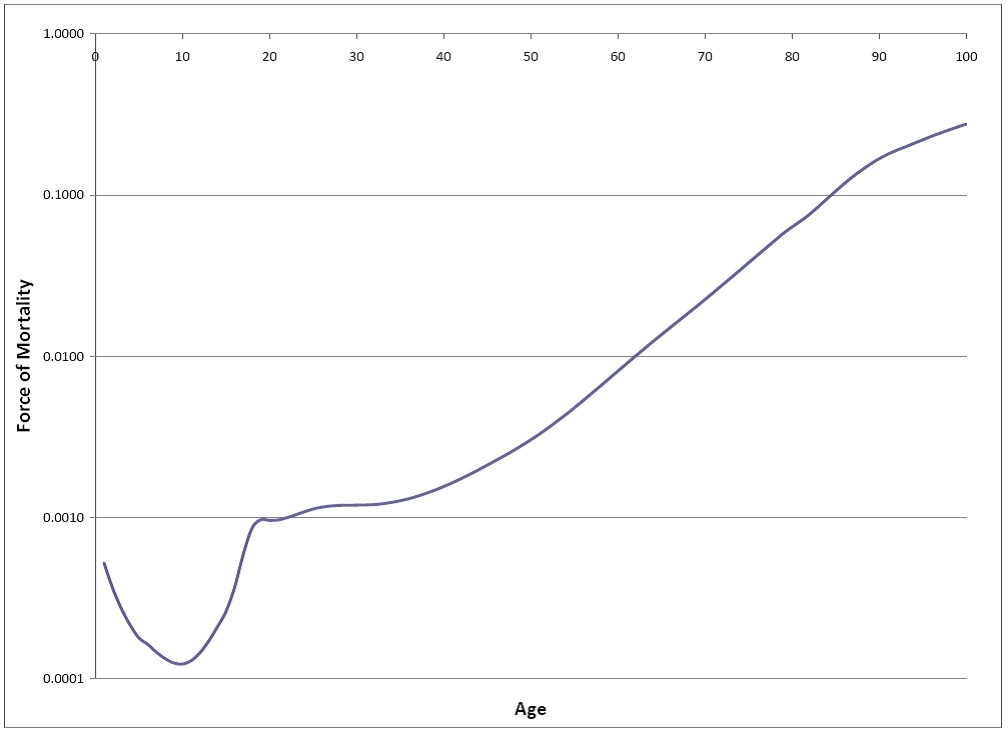
We observe that the force of mortality graph looks similar to a plot
of
- decreasing at young ages,
- increasing in late teens/early twenties, and
- increasing as age increases.
This is typical in the developed world.
How does that compare with a formula like
Gompertz law on a portion of Australian data #
The following plot shows Gompertz law fitted to Australian Life Tables Males
2000-02, for ages 50–100;
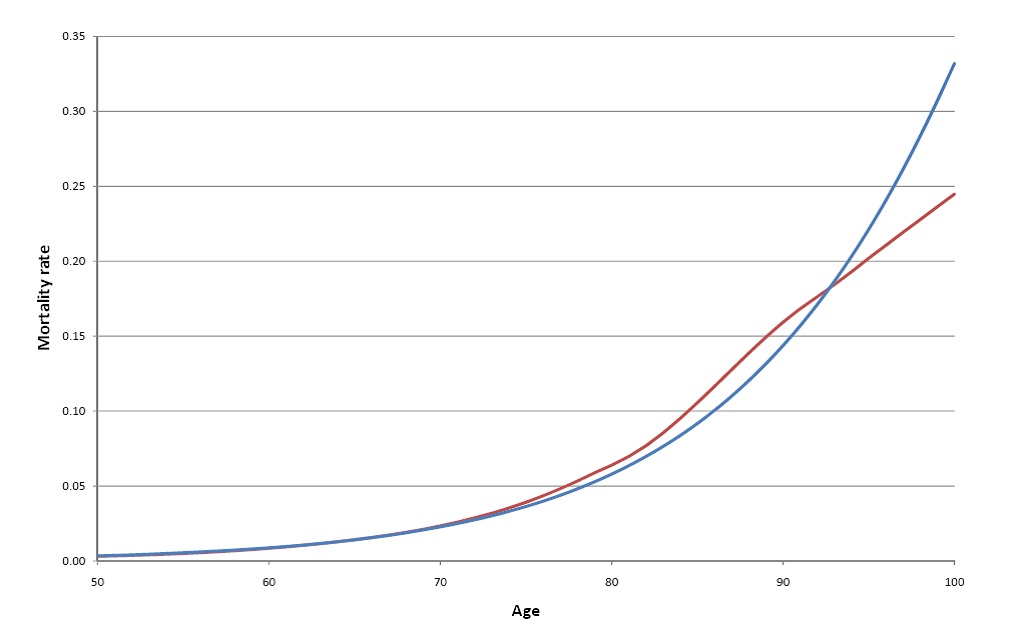
How was that fitted?
- In Australian Life Tables 2000–02 Females,
- We set
- Then
- Hence an estimate of
- Estimates in the tail would be quite off.
Measures of fertility #
Definitions #
- Births are a natural source of increase for national populations. Another source of increase is immigration. Here we focus on births only.
- There are a number of summary statistics commonly used to describe features of fertility experience, such as
- General Fertility Rate (GFR)
- Age Specific Fertility Rate (ASFR$_x$)
- Total Fertility Rate (TFR)
- Gross Reproduction Rate (GRR)
- Net Reproduction Rate (NRR)
General Fertility Rate (GFR) #
The calculation is based on births in a fixed period of time, usually a calendar year.
In Australia, there were
Comments on GFR #
- Crude Birth Rate (CBR)
- While GFR is better than CBR, a disadvantage of GFR is that it will be affected by the age distribution of women aged 15-49, which reduces its comparability.
In what follows we define the age specific fertility rates (ASFR) which are independent of the age distribution of the female population.
Age Specific Fertility Rate (
-
The Age Specific Fertility Rate (
-
The Total Fertility Rate (TFR) is
- The ASFR can also be defined as fertility rates of women aged over an age group, 15-19, 20-24, 25-29, etc. For example,
- Thus, we could use the ASFR to compare, e.g., fertility rates of women aged 30–34 in Victoria and NSW without concerning ourselves with the population structure in these states.
Comparison of TFR with GFR #
Consider the following data in a given year:
| age | 15 | 16 | 49 | |||
|---|---|---|---|---|---|---|
| # of women | ||||||
| # of live births |
Now, the GFR was calculated as
Here
This is what changes from one population to another in the GFR, and which is somewhat standardised in the TFR (equal weights). In other words: If the proportion of women changes from one population to another, everything else being equal, this will impact the GFR but not the TFR.
Similarly, the age specific fertility rate over an age interval, say
Summary #
- GFR is the weighted average of
- TFR is the sum of
- TFR is the number of the live births per 1000 women over their reproductive ages, assuming no mortality.
- To sustain population,
(roughly, but that depends on mortality etc…)- 2.1 is called the replacement level fertility.
- In Australia,
Age Specific Fertility Rates in Australia #
The chart below shows ASFRs for Australia over the period 1999–2009.
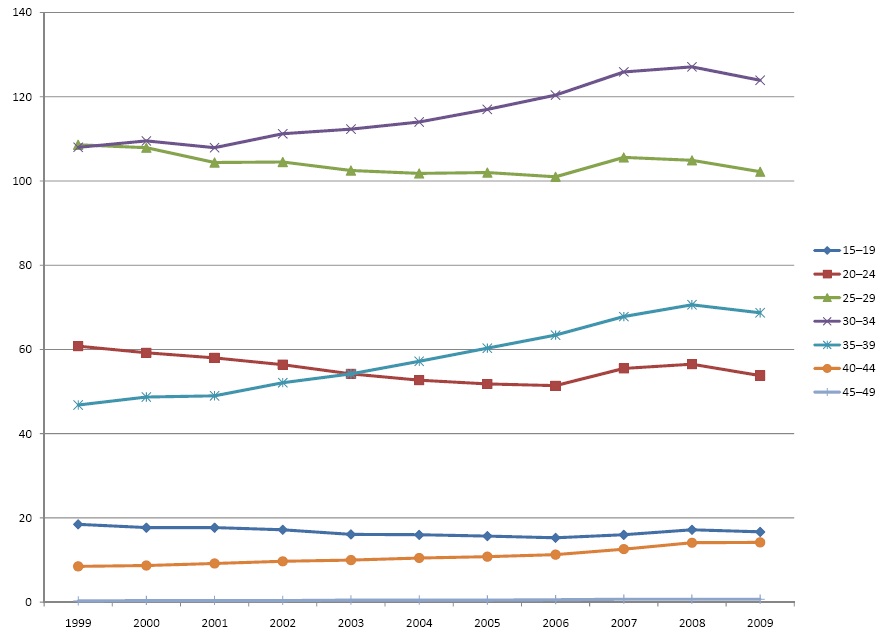
Observations:
- Fertility rates have fallen for women in their 20s
- Fertility rates have risen for women in their 30s
- There is a downward trend at ages 15–19 and an upward trend at 40–44, but these are small changes compared with other age groups.
- No real change at ages 45-49.
Gross Reproduction Rate (GRR) #
- Fertility rates tell us about how many babies are being born.
- Reproduction rates focus on the birth of female babies, because they are the only ones who will eventually be able to have babies themselves, later on. As the sex ratio at birth changes from one population to another (and also potentially across ages) then this makes a difference.
- Let
- Thus,
- The Gross Reproductive Rate (GRR) is then defined as
Comparison of TFR with GRR #
Remember
If we assume we need
Example 11 #
The following data from ABS relate to Australia in 2006. Estimate the GRR.
| Age Group | ASFR |
|---|---|
| 15–19 | 15.4 |
| 20–24 | 51.6 |
| 25–29 | 100.8 |
| 30–34 | 120.1 |
| 35–39 | 63.3 |
| 40–44 | 11.3 |
| 45–49 | 0.6 |
Answer:
- The rates are per 5 year age group. When data are presented like this it is
standard practice to assume that the given ASFR applies at each age in a
group.
- Thus, e.g., we assume
- Thus, e.g., we assume
- The same assumption applies to each age group, so
- Our data are not split by gender, so if we assume a sex ratio at
birth of 1.05, we get
Note that several layers of approximation were used here:
- We used grouped ASFR to approximate the TFR:
- We estimated the female ASFR using sex ratios at birth.
- We used a single sex ratio for all ages.
Net Reproduction Rate (NRR) #
- This is defined as the number of live female births surviving to the ages their mothers were at their births per 1,000 woman in an age group.
- It is a measure of the rate at which a woman of age
- Thus,
- Note that we assume that women giving birth at age
- Frequently the age range is 5 years, or 10. If so, remember that the average age is half way through this range.
Example 12 #
Calculate the NRR from the following data.
| Age Group | ASFR | Survival Factor |
|---|---|---|
| 15–19 | 15.4 | 0.99279 |
| 20–24 | 51.6 | 0.99107 |
| 25–29 | 100.8 | 0.98921 |
| 30–34 | 120.1 | 0.98703 |
| 35–39 | 63.3 | 0.98410 |
| 40–44 | 11.3 | 0.97991 |
| 45–49 | 0.6 | 0.97377 |
Assume that the survival factor applies from birth to the age in the middle of each age group.
Answer:
| Age Group | ASFR | Survival Factor | |
|---|---|---|---|
| (1) | (2) | (3) | (2) |
| 15–19 | 15.4 | 0.99279 | 15.2889 |
| 20–24 | 51.6 | 0.99107 | 51.1392 |
| 25–29 | 100.8 | 0.98921 | 99.7119 |
| 30–34 | 120.1 | 0.98703 | 118.5417 |
| 35–39 | 63.3 | 0.98410 | 62.2932 |
| 40–44 | 11.3 | 0.97991 | 11.0730 |
| 45–49 | 0.6 | 0.97377 | 0.5843 |
Finally
Factors affecting fertility #
- Standards of nutrition, sanitation, and health more broadly mainly have an impact on child survival, but they do have some impact on the success of pregnancies (and the wish of parents to have children) as well.
- Then how many babies to have is mostly a matter of choice, and population circumstances have an impact on those choices:
- In general, increased prosperity leads to lower fertility rates.
- Individuals delay parenthood, and limit the number of children.
- Philosophical and religious convictions may have an impact, too.
- Some countries may decide to implement strict birth policies (e.g. China).
- Importantly, developing countries may have high fertility rates, but low reproduction rates, due to poor health. These highlight how different both types of indicators are.
Trends in fertility rates, and consequences #
- Trends in fertility rates for developing countries are typically as follows:
- Women are having fewer children over their reproductive lifetime.
- Women are choosing to have their first child later in life.
- Complete family size is falling.
- A consequence is an increase in generation gap, whereby parents are typically 30-40 years older than their children (as opposed to 20-30 years older).
- This, coupled with reduced mortality at all ages, leads to an ageing of the population, which has serious consequences.
- Recall the increasing age dependency ratio.
- Elderly people may not have large families available to care for them (they had no children, or they moved overseas), and there are less active people to fund their care (at society level).
Population projections #
- A population projection gives a profile of a population in the future, based on current (and past) data, and our view as to how the population will change over time.
- There are many reasons why we might be interested in knowing what a population will look like in the future. For example, to estimate the cost of providing a particular service (education, health care, social security payments, etc) to a particular group in the population.
- There are a number of different models and methods commonly used to estimate population size based on different types of growth.
Polynomial model #
Let
As a special case, the linear model is
Geometric population growth #
This method assumes a compound rate of growth
For example, we may use the information from past years and extrapolate to the future.
This method has the advantage that it is very simple to apply.
It has the disadvantage that it is very simplistic!
Example 13 #
A country’s population in 1990 was 12 million. In 2000 it was 14 million.
Assuming geometric population growth, project the country’s population in 2015.
Answer:
- We have
- Then
Logistic model #
Populating growth under the logistic model is represented as
Example 14 #
The population of a certain country is currently 20 million.
The population is estimated to grow by 1.5% over the next year.
Assume that the population will grow to a limiting value of 25 million.
Estimate the population size in 50 years’ time under a logistic model
of population growth
Answer:
- We know
`
- Also,
`
- Lastly, we know that
- Thus,
The population here grows as in the graph below.
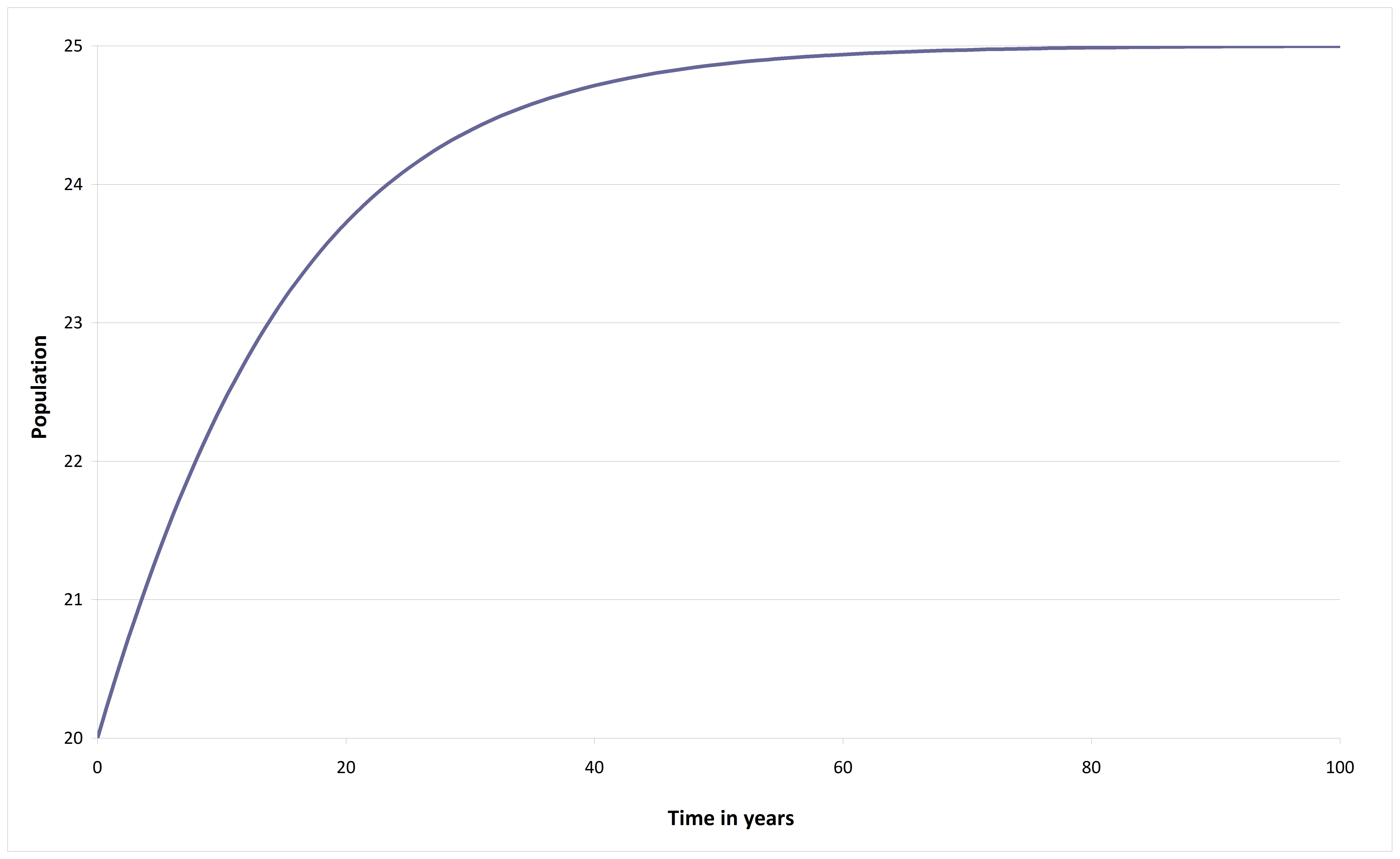
Component method #
- Finally, there is the component method. This is detailed and models the ‘components’ which contribute to growth or decline of the population.
- Simply put,
population clockshowing estimates of how Australia’s population is projected into the future. It uses such a component model. - This method enables assumptions about the mortality, fertility, immigration and emigration rates in as detailed a way as we wish.
- It also enables us to investigate the effects of different rates/assumptions have on future population growth and distributions (“what if” analysis), which is crucial for decision making.
References #
Here is the correspondance of sections with the book Atkinson and Dickson (2011):
- Section 1: 3.3.1
- Section 2: 3.3.2
- Section 3: 3.3.3
- Section 4: 3.3.4
- Section 5: 3.4
- Section 6: 3.5
Atkinson, M. E., and David C. M. Dickson. 2011. An Introduction to Actuarial Studies. 2nd ed. Edward Elgar.